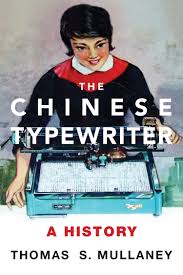In The Chinese Typewriter: A History, Thomas S. Mullaney offers the first of two volumes exploring the global history of Chinese information technologies by focusing on the development of the Chinese typewriter. Challenging easy narratives and offering digestible insight into technological concepts, this is an incredible work of scholarship, writes Ed Jones, that is as much a history of the past as it is one for the future.
The Chinese Typewriter: A History. Thomas S. Mullaney. MIT Press. 2017.
Today, China is synonymous with acceleration. Economists ponder why China’s economy is growing so fast, journalists explore rapid urbanisation and its perils while best-selling books such as Leslie T. Chang’s Factory Girls: From Village to City in a Changing China paint vivid pictures of the social and cultural effects of speed in protean industrial cities. In the Western media, this acceleration is frequently reified and moralised through tales about China’s relationship with the mobile phone: the implementation of phone lanes for pedestrians and images of buses teeming with Chinese faces quietly staring at their mobiles denote creeping societal alienation in a country bound by a deep sense of tradition. The swift rise of the middle class has prompted a voracious demand for iPhones. Their production in questionable working conditions has also become a common target for critics of unbridled capitalism.
Thomas S. Mullaney’s The Chinese Typewriter: A History is the first of two volumes offering ‘a global history of Chinese information technology’. Throughout the nineteenth century, the concept of a Chinese typewriter was a popular signifier of Chinese alterity. Mullaney sheds light on its protracted influence with examples from US popular culture from 1973 that still drew on the image of an unwieldy typewriter machine as a trope of Chinese backwardness. In the eyes of the nineteenth-century Western world, Mullaney explains, the Chinese language, made up of thousands of characters, failed to ‘fit’ the typewriter, and the Chinese language was made to appear as ‘a great hindrance to the development of the sciences’, thereby threatening to exclude China from the modern world. The creation of a Chinese typewriter therefore became a ‘civilisational trial’ for a country that feared ‘functioning in slow motion’ in the face of global acceleration.
Mullaney’s tale is a patchwork of histories from across the globe. The first chapters are made up of forgotten ‘scrap-notes of history’. US corporations such as the Remington Company streamlined typewriters and steamrolled over early attempts to create typewriters for non-Latin scripts. In 1858, the year Cyrus West Field established the first transoceanic telegraph cable across the Atlantic, the Irish-born American William Gamble travelled to Ningbo to oversee operations at the Presbyterian Mission Press. With the help of two Chinese assistants, Gamble conceived of a way of arranging Chinese characters in a matrix that accounted for the relative frequency of characters in Chinese texts. Whereas Gamble was interested in capturing the linguistic intricacies of the Chinese language, others sought to amputate parts to encase it in the typewriter. In 1862, the linguist Pierre Henri Sanislas d’Escaryrac de Lauture proposed to fracture Chinese radicals and characters in order to allow for its transmutation into a telegraphic language ‘more succinct and intelligible to all people’.
 Image Credit: Mrs. N. M. Cheolin, typist, with Chinese typewriter, 1961 (Vancouver Public Library CCO)
Image Credit: Mrs. N. M. Cheolin, typist, with Chinese typewriter, 1961 (Vancouver Public Library CCO)
In the early twentieth century, the Chinese government sought to replace the teaching of literary Chinese with the vernacular, and prompted a series of young Chinese men, such as Zhou Houkun and Qi Xuan, who had studied in Ivy League universities, to explore new and faster methods to disseminate information. Zhou created a typewriter ‘with no keys’ that relied on a tray bed of characters arranged on the basis of frequency. A rod connected the characters on the bed to those on a cylinder; upon pressing down on a character on the tray, the cylinder would imprint it on the paper. Subsequent improvements on tray-bed typewriters prompted awe at home and abroad, but the process remained slow and cumbersome.
The second half of the book introduces the influence of regional politics upon technological development. Over the 1930s, Japan’s occupation opened the door for Japanese-made typewriter companies to achieve a monopoly; in response, the creation of a Chinese national typewriter became a pursuit of national pride. In this context, Lin Yutang developed the Mingkai typewriter: 29 keys ‘found’ characters within the machine on the basis of the number of times a certain key was pressed. China’s involvement would stem US interest in the typewriter, but also laid the basis for the growth of typewriting under Mao: the subject of Mullaney’s forthcoming volume. The last pages of this book serve as a preface to the next: predictable Communist nomenclature and the need to diffuse propaganda throughout the country enabled the reconfiguration of Chinese typewriters to allow for ‘predictive text’.
Mullaney’s history of Chinese technological change is an incredible work of scholarship. The recovery of forgotten ways to think about the future of technology, as well as his analysis of how the relationship between alterity, politics and information ‘rewired the circuitry of global power’, opens the door to new studies on the global history of information overload. The book reads as a personal endeavour and contains many imaginative explorations of the ties between orientalism and technological development. Yet, the style does often get in the way of the book’s analysis. Rather than being shepherded through long metaphorical explorations, a broader historical context of technological changes and political reform in China may have paved the way for more connections with the wider historiography on Asia and the Pacific. However, Mullaney’s style allows the reader to digest abstruse technological concepts and deserves great praise for facilitating the understanding of intricate machines and engaging the reader in complex issues of ‘semiotic sovereignty’.
To this day, the complexity of the Chinese language continues to arouse fascination and parody. Mullaney addresses the origins of many of the stereotypes that remain about China and its efforts to fuse modernity and tradition, and also challenges easy narratives about the world’s second largest economy. In 2014, the Taiwanese entrepreneur ShaoLan Hsueh published Chineasy: The New Way to Read Chinese. The book illustrates Chinese characters to create mnemonic devices for new learners. Shaolan declared ‘people look at Chinese and see this Great Wall of China. I want people to understand China (…) Asians make so much effort to learn English it’s embarrassing.’ In the twenty-first century, the West is entertained by another attempt to make the Chinese language easier for Western readers, while many in Asia work hard to learn European languages. Mullaney’s book is as much a history of the past as it is one for the future.
Ed Jones is a graduate of the LSE and a PhD Candidate in History at the University of Cambridge, with a focus on early modern Spain. Read more by Ed Jones.
Note: This review gives the views of the author, and not the position of the LSE Review of Books blog, or of the London School of Economics.


 Find this book:
Find this book: 




